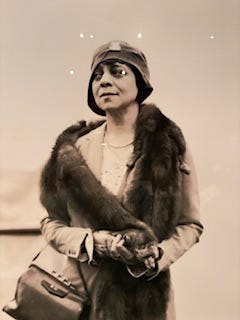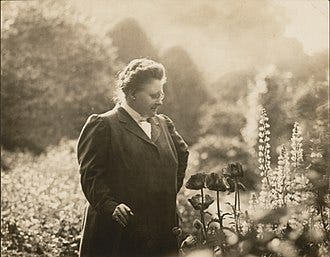Finding Lost Voices: Belle da Costa Greene and Amy Lowell
A weekly email that brings back the voices of those who have been forgotten or misremembered
Welcome to the latest issue of Finding Lost Voices. Thank you to all who have become paid subscribers. I appreciate your support. If you’ve enjoyed these posts and have the means, please consider becoming a paid subscriber.
A few weeks ago, I visited the Belle da Costa Greene exhibit at the Morgan Library in New York City. I’d heard about the exhibit (then still in development) on a tour arranged by the Biographers International Organization last May, where the Robert H. Taylor Curator and Department Head, Philip S. Palmer, shared a selection of artifacts from the Morgan collection with us as a way to introduce us to it. It was there that I first became acquainted with Greene and was thrilled to hear that a large exhibit was being developed to showcase her life and her extraordinary influence on the development of the Morgan collection.

The afternoon I visited the museum, I took the subway up from where I was staying on Washington Square. When I exited the dark subway, I was overwhelmed with how bright and vibrant the city had become. It was one of those brilliantly sunny spring days in New York where everyone is outside, sitting in parks or walking on the sidewalks, soaking up the sun. When I entered the exhibit, it was packed—everyone sweating from their sun exposure—but I waded my way through the crowd and started to follow the narrative of Belle da Costa Greene’s life (1879–1950). (I wrote briefly about her life in a previous Finding Lost Voices column, which you can read here.) Greene ran the Morgan Library for forty-three years. She began her career as the private librarian of J. Pierpont Morgan and later became the inaugural director of the Pierpont Morgan Library, now known as the Morgan Library. But as Philip Palmer explains in the introductory statement in the audio tour of the exhibit, to call Belle da Costa Greene simply a librarian would be a vast understatement. “This was a librarian who spent fortunes at rare book auctions and commanded respect from prominent European curators. This was a librarian regularly featured in newspaper articles on the best-paid women in America, someone who collected fine art and Chinese sculpture. This was a librarian who drove a convertible and cavorted with aristocrats, who dined with avant-garde artists and parodied Gertrude Stein. This was a librarian, in other words, with verve and style uniquely her own.”
Greene was born Belle Marion Greener, the daughter of Genevieve Ida Fleet Greener (1849–1941) and Richard T. Greener (1844–1922). Her father was the first Black graduate of Harvard College. After her parents separated in the 1890s, her mother changed the family surname from Greener to Greene. Additionally, Belle adopted the middle name da Costa, and she (and the rest of her family) began to pass as white in a racist and segregated America. Greene burned her papers, but despite this, the exhibit felt incredibly comprehensive, giving us insight into her extraordinary life.
As I pushed through the crowded exhibit and entered the second room, I was surprised to find a placard describing Greene’s interactions with poet Amy Lowell (1874–1925). Lowell had reached out to Greene before one of her visits to New York while researching her two-volume biography of Keats (published by Houghton Mifflin Company in 1925).
While in my Ph.D. program at Case Western Reserve University in Cleveland, Ohio, I wrote my dissertation on Lowell. I was drawn to her work because of her extraordinary lyric poetry and her interactions with Ezra Pound during the Imagist era. Pound adamantly disliked Lowell, thinking she was loud and opinionated. She didn’t back down in the face of his criticism, and I loved her for it. Lowell also wrote openly about her relationship with her partner Ada Dwyer Russell in many of her books, including her extraordinary sequence Two Speak Together. She was able to publish this work during an era when such themes weren’t accepted, largely because everyone assumed she was writing in the voice of a man. They thought a full-bodied woman couldn’t possibly be writing these poems as a reflection of herself. Once again, Lowell was misunderstood—but it was this very misunderstanding that allowed her to publish such incredibly erotic lesbian poems.
Lowell was born into a prominent family in Brookline, Massachusetts. She grew up on the family estate, called Sevenels (named after the seven members of the Lowell family who lived there). While her family eventually moved away, Lowell spent the rest of her life living on the estate. She had a bedroom built on the top floor of the house, which she called her “Sky Parlor,” and it was there, in her large bed, looking out the large windows into exquisite gardens below, that she wrote many of her poems.
Although Lowell’s brother, Abbott Lawrence Lowell, would become president of Harvard, Lowell, as a woman, was not allowed to use the university’s library for research purposes. She published seven books of poetry during her lifetime, and Russell later published two volumes of her work posthumously. Lowell received a Pulitzer Prize for her collection What's O'Clock, published in 1925.
Toward the end of her life, Lowell began researching the life of her favorite poet, John Keats. She had long been a collector of literary treasures, starting at 17 when she used her Christmas money to purchase Sir Walter Scott's Waverley novels. She began collecting Keats’s archival materials in 1902 when she purchased a love letter from Keats to his love interest, Fanny Brawne. Lowell went on to collect other Keats artifacts, including more love letters, the volume of Keats’s Poems that he gave to Brawne, a lock of Brawne’s hair, the working manuscript of To Autumn, and Shelley’s letter inviting Keats to visit him in Italy. Her reliance on these primary source materials—many of which hadn’t been available to previous biographers—became crucial to her work.
It was during this time, while researching her book on Keats, that Lowell reached out to Greene. In her letter, she requested to see "the Morgan library’s Keats manuscripts, etc.” because she knew they had “not only the ‘endymion” etc., but the communication from Woodhouse to Taylor and things of that sort.”
Greene respected Lowell. Both women were wealthy and navigated the male-dominated world of purchasing literary artifacts with ease. They also shared the experience of living in a society that didn’t fully accept their identities. Perhaps that’s why, when Lowell visited New York later, after surgery, she wrote to Greene asking if she could keep one of the Keats manuscripts overnight in her hotel room so she could work on her writing in comfort. As the placard in the exhibit revealed, Greene agreed to this unusual arrangement, demonstrating how much she trusted Lowell.
When I left the exhibit, the sun was still blazing. I decided to walk back from the Morgan to Washington Square, taking time to process what I had seen while observing New Yorkers’ joy as they sat on park benches, their heads thrown back, basking in the spring sun. I, too, felt joyful, thinking about how these two extraordinary women had not only known each other but had truly seen each other for who they were.
Upcoming Events
Come join me at one of my upcoming events!
April
April 12 - 3:00 PM Iris Jamahl Dunkle reads at Full Circle Bookstore, Oklahoma City.
May
May 17 - 5:30 - 7:30 PM - Iris Jamahl Dunkle at the National Steinbeck Center, Salinas, CA
May 20 - 6:00 - 8:00 PM Iris Jamahl Dunkle, Dana Gioia and Elise Paschen Reading at Dominican Edgehill Mansion 75 Magnolia Avenue San Rafael, CA 94901








I loved the fictional account of her life, I think called "The Librarian." So powerful.
A wonderful introduction to a poet I haven't read yet. Just checked one of her books out of the library. Thank you!